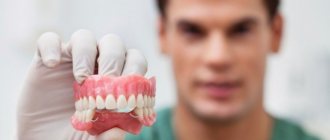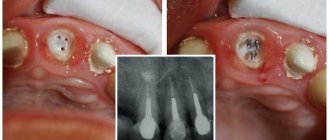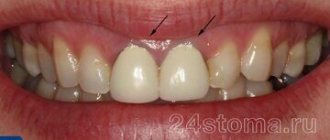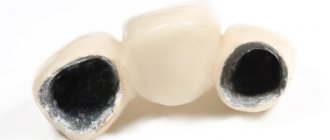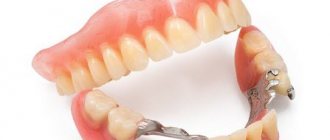A clasp denture is an ideal solution for restoring a number of teeth in the lower jaw, when the patient has retained several of his dental units, but it is not possible to install a full-fledged bridge on them for objective reasons. Also, this design is ideal if the patient does not want (or cannot) install implants, but wants to restore his smile and achieve optimal results for a reasonable budget. Yes, the clasp prosthesis for the lower jaw is a removable model, but it copes with the task perfectly, is a worthy alternative to outdated plate models, and the service life of such a solution is from 10 years.
Removable clasp prosthesis for the lower jaw - consider in detail
Why is a denture for teeth called clasp? The name itself comes from the word “arc”. It is based on a thin cast arc-shaped metal element, onto which a plastic base imitating gum is fixed, as well as artificial crowns - smooth and beautiful teeth. Thanks to the arch, the teeth replacement system is highly durable and reliable, because it will have to be removed and put on at least once a day. As a result, the patient receives a compact, lightweight, comfortable prosthesis for the lower jaw, which is easy to get used to in the first few hours after installation.
How is the prosthesis fixed on the supporting, pre-prepared teeth of the lower jaw? Using hooks or special elements. They are placed on top of the patient’s teeth or on pre-implanted implants. By the way, the prosthesis locks themselves are made not only of a metal alloy, but also of plastic, which is especially important for people with an allergic reaction to metal. But the gums can be made of either nylon or plastic bases (acri-free, quadrotti solutions). When it comes to dental crowns, they are usually made from a plastic material that imitates enamel.
It is important! The specificity of the prosthesis for the lower jaw presupposes that the arch is located on the side of the tongue, that is, where it is not visualized at all. The distance from the arch to the cervical area of the teeth is approximately one millimeter, and a little more is the distance to the bottom of the mouth.
New generation dentures without palate
Removable dentures on telescopic crowns are the most reliable type of clasp denture in terms of stability and durability. The product consists of two separate elements: removable and main, fixed in the jaw on supporting teeth or implants.
To fix the prosthesis, the patient’s own teeth are ground down, after which a special mount in the form of a cap is installed on them. It covers the tooth and serves to protect it from destruction, while at the same time holding the removable part of the denture. The second (removable) part of the prosthesis has a similar part, which is connected like a telescope and held in the oral cavity.
The parts of the locking mechanism fit into each other with a high degree of fit. Telescopic crowns allow you to install and remove a prosthesis, replace and repair individual elements. At the same time, the appearance of the mechanism is completely hidden from others. When talking and smiling, other people do not see that there is a removable denture in the mouth.
To make a prosthesis on telescopic crowns, various materials can be used, as a rule, it is a metal clasp made of a metal alloy (nickel, chromium, cobalt, dental steel, etc.). To cast it, impressions are taken from the jaw, after which a model of the jaw and the future prosthesis is made. The fixed part is fixed to the abutment tooth using dental cement and serves as a support for the removable part.
A prosthesis on telescopic crowns, as a rule, has a reliable internal metal frame. For some types of products, for example, acrylic, acry-free can also be used as a type of fixation using telescopic crowns. However, in this case the frame will be polymer, not metal. Therefore, this type of prosthesis can be recommended for patients who are allergic to metal.
To make the product more durable and wear-resistant, zirconium dioxide or metal ceramics are used as artificial teeth, which can also be used as a frame. The frame allows you to evenly distribute the load between the supporting teeth, reducing pressure on individual points. Reliable fixation on several supports increases the ease of use of the prosthesis; it does not move or fall off, and copes well with the chewing load.
Unlike plate-based frameless devices, a durable base helps reduce the rate of bone resorption. The tissues of the jaw sag less over time, as they experience the natural chewing load. Despite the fact that atrophy does not stop, its rate decreases from 1 mm per year to 0.3-0.5 mm, which helps to extend the service life of the prosthesis by 2-3 times.
Your own teeth or implants are used as support. Without reliable support, a denture without a palate will not hold tightly when talking, chewing, or smiling. This is explained by the insufficient adhesion force, which is ensured by the massiveness of the structure in classical prosthetic models (they are larger and take up significant space in the oral cavity).
It is recommended to install artificial supports in case of complete absence of teeth. Implants are implanted into the bone tissue during implantation. The procedure is painless, as effective local anesthesia is used. After complete implantation, artificial supports are not felt, do not cause discomfort or pain, and fully compensate for the absence of several dental units. The bone tissue around the implants is preserved longer, preventing their loss.
Indications for prosthetics
Clasp dentures are installed on the lower jaw if:
- there is an extensive defect - for example, more than two teeth in a row are missing;
- all teeth are completely missing - in this case, to fix the prosthesis, the patient is first implanted with supporting implants;
- the last teeth in the row are missing;
- The patient has chronic periodontitis and there is a need to additionally strengthen the remaining teeth in the row with the help of a prosthesis.
In the meantime, prosthetics with clasp artificial structures are not recommended when:
- there are less than four teeth left in the jaw - unfortunately, this is not enough for a high-quality support base;
- the patient suffers from acute chronic illnesses;
- bone problems have been diagnosed (for example, osteomyelitis of the jaw, as well as osteoporosis);
- a person has an inflamed oral mucosa.
Indications for installation
Splinting clasp prosthetics is used in the following situations:
- Loss of 3-5 adjacent teeth if there is no reliable support on either side.
- Gum pathologies accompanied by frequent bleeding.
- Loss of a tooth and loosening of several of its neighbors.
- Bruxism, abnormal deep bite.
- Formation of voluminous gum pockets, exposure of tooth roots.
- Periodontal diseases.
If teeth are loose and periodontal tissue is damaged, splinting should be done as soon as possible. If this is not done, the radical units will begin to fall out. Under the influence of high chewing load, the teeth will begin to tilt in different directions and change their original position. Clasp splinting prosthetics allows you to avoid all these consequences.
The process of getting used to the clasp prosthesis - features and nuances
The process of getting used to a clasp denture installed on the lower jaw is not at all quick. At first, the patient may be bothered by excessive salivation and discomfort while chewing food. There may also be speech defects - it is difficult for a person to pronounce hissing and whistling sounds. Also, at first you may feel a slight rubbing of the oral mucosa, but this is normal.
If discomfort when wearing dentures bothers you for more than a week, you need to visit a dentist. The system may need to be adjusted slightly to resolve the discomfort.
An alternative to telescopic structures
What can modern dentistry offer if a prosthesis on “telescopes” is not suitable for you for some reason? There are other methods of restoring teeth:
- removable products with clasps: seriously inferior to telescopic systems in aesthetics,
- clasp products with attachments (micro-locks): a good option, but not suitable if you have few teeth,
- nylon structures: inferior in terms of service life. In addition, they cannot be corrected in case of tooth loss,
- installation of implants: recognized as the best possible alternative, but much more expensive.
The choice of a specific method largely depends on the characteristics of the clinical picture, including the number of lost teeth and the financial capabilities of the patient. You need to understand that the best solution that will restore the appearance and full functionality of the dentofacial apparatus, as well as stop the atrophic processes in the jaw bone tissue, is dental implantation.
How much does a clasp prosthesis cost?
The price of lower jaw prosthetics using a clasp design depends on the following factors:
- base and frame material;
- the number of teeth that need to be restored with a prosthesis;
- material for dental crowns.
The average price of a clasp prosthesis is from 32,000 rubles. The price, as a rule, already includes payment for the prosthesis itself, treatment planning, installation of the system, and check-ups with the dentist.
Clasp dentures are an inexpensive and accessible way to restore a smile with a long service life (more than 10 years).
Clasp prosthesis - what is it?
Clasp dental prosthesis is a removable structure that is used when necessary to restore the integrity of the dentition.
“Byugel” translated from German means an arc, which is exactly at the heart of the structure. With its help, the load is evenly distributed over the entire dentition, which allows you to preserve adjacent healthy teeth for as long as possible. Clasp dentures are excellent in cases where it is not possible to use fixed bridge systems. They have become a worthy alternative to nylon and acrylic counterparts.
The system itself consists of the following parts:
- metal arc;
- fasteners for fastening;
- plastic base for attaching artificial teeth.
Fixation can be performed using clasps, locks, telescopic crowns and a beam system.
Difference between dentures for the upper and lower jaw
Clasp dentures for the lower jaw experience a greater chewing load, but they are easier to manufacture than clasp dentures for the upper jaw. And there are not such high requirements for them in terms of the number and location of supporting teeth.
To install a prosthesis on the upper jaw you must:
- presence of at least 6 supporting teeth
- uniform distribution of healthy units along the jaw arch
- the patient should be prepared for the palatal arches and get used to them (there may be several of them, it all depends on the specific case)
For clasp dentures for the lower jaw, it is important that there is no atrophy of the alveolar process tissue, so that the gums do not sag, and strong supporting teeth.
Indications and contraindications
Indications:
- partial edentia with loss of one or more units;
- the presence of periodontal damage;
- severe loosening of units;
- the presence of two supporting teeth for fastening the structure;
- impossibility of installing implants;
- low height of natural teeth used as supports.
Despite the advantages of this type of design, the installation has many contraindications:
- there are no supporting teeth;
- severe destruction of bone tissue at the site of prosthetics;
- infections, inflammatory processes in the oral cavity;
- increased abrasion of support units;
- pregnancy;
- the presence of allergic reactions to structural components;
- radiation therapy performed;
- various jaw pathologies, including low palate, deep bite;
- mental illness;
- diseases of the cardiovascular and respiratory systems during exacerbation;
- diabetes.
Installation Features
Prosthetics includes several stages:
- preparation, preliminary examination, diagnostics;
- if necessary, support units are treated and infectious tissue lesions are eliminated;
- taking impressions, installing a temporary structure;
- making a prosthesis, fitting;
- installation of a clasp structure.
Rules of care
The service life of clasp dentures is on average five years. But to avoid complications and extend service life, you must follow the following rules of care:
- regular cleaning of teeth, including the surface of the prosthesis using paste, brush, irrigator;
- after each meal, the oral cavity should be rinsed with special solutions;
- You should periodically visit a doctor for preventive examinations.
Approximate prices
The average price for clasp dentures in St. Petersburg is 27-45 thousand rubles. But the exact cost can be increased due to the following factors:
- diagnostic procedures before prosthetics;
- the need for treatment before prosthetics;
- number of units to be reimbursed;
- materials used to make the structure;
- types of locks for fixation.
To make an appointment or get additional information about the installation of prostheses, the cost and features of treatment, please contact us by phone. Call us and make an appointment at a time convenient for you.
Service life and care rules
The minimum service life of a telescopic prosthesis is 3 years. With proper care, the structure can last longer - up to 10 years. Like all dentures, over time they become less secure and require correction. To maximize the life of the structure, it is recommended to regularly visit the dentist and properly care for the prosthesis.
Telescopic dentures are designed to be worn around the clock - there is no need to put them in water before going to bed. The structure will only need to be removed for hygienic cleaning. Care activities include:
- cleaning dentures after eating (it is advisable to use special brushes for dentures with long bristles and a wide head;
- use of tablets to clean dentures (in consultation with the dentist);
- prof. examinations by a doctor to check the condition of the prosthesis.
To avoid damaging the structure during home cleaning, it is best to remove and put on the prosthesis in front of a mirror over a soft surface or over a sink with water or a towel (if the prosthesis slips out of your hands, it will not be damaged).
Advantages and disadvantages of implants
If no contraindications are identified, then dentists advocate implantation. The only people against implants are doctors who do not have sufficient qualifications to perform such operations and recommend the installation of a removable prosthesis in their own interests, and not in the interests of the patient.
After all, the undeniable advantages of implantation are the restoration of the functions of a lost tooth, the prevention of deformation of bone tissue and facial features, and the absence of the need to grind adjacent teeth.
For many, the rather high price can be an obstacle to installing implants. But implantation pays off in the future, because as stated above, I install implants for almost my entire life.
